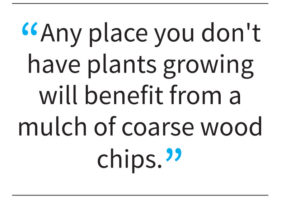Your Garden … with Kate Russell: While pruning trees and bushes, simply chop and leave plant material on ground
Click HERE to find more stories published in the May 15 – 28, 2019 issue of Gilroy Life
 Each spring, Gilroy gardeners are busy trimming and pruning. All that plant material is then composted before being returned to planting beds. In many cases, you can simply chop and drop where you stand.
Each spring, Gilroy gardeners are busy trimming and pruning. All that plant material is then composted before being returned to planting beds. In many cases, you can simply chop and drop where you stand.
Rather than adding to your workload, copy Mother Nature. Simply chop plant material where you find it and drop it on the ground.
Insects, animals, microbes, rain, and foot traffic will move that chopped plant mulch into the soil, improving soil structure and adding important nutrients, just as it has since plants arrived on the planet’s surface. No wheelbarrow required.
Any place you don’t have plants growing will benefit from a mulch of coarse wood chips.
 This mulch creates a buffer against erosion and temperature extremes, simplifies weeding, and slows evaporation.
This mulch creates a buffer against erosion and temperature extremes, simplifies weeding, and slows evaporation.
As you chop and drop, plant material will eventually break down and move into the soil below the wood chips, where it can improve soil structure and feed nearby plants.
If you think it looks messy, chop while standing behind the plant instead of in front. Of course, you should still get your soil tested every three to five years, to make sure there are no deficiencies or toxicities.
You don’t have to chop plant material into smaller bits if you don’t want to. It will simply take longer to break down. Chopping simply speeds the decomposition process. Dropping it where you found it puts nutrients back where the plant can reuse them.
Come autumn, when leaves start falling, leave them where they fall, unless they fall on your lawn. In that case, mow them where they fall, or blown them into flowerbeds and around shrubs and trees, where they create a protective winter blanket that becomes food in spring.
Some claims are made about plants containing especially high levels of nutrients, making them perfect for chop and drop mulching. These ‘dynamic accumulators’ are mostly hype. Plants contain a wide variety of elements used to help them grow. Some produce more volume, or biomass, than others. That’s all.
While chopping and dropping is an excellent way to save time while improving soil health, you don’t want to drop heavily diseased or infested plant material where reinfection or re-infestation can occur.
Diseased plant material should be thrown in the trash. Unless they have gone to seed or are spread by runners, weeds can be pulled, chopped, and dropped where they are.
All the weed plants with seeds can be fed to your chickens or you can add them to your compost pile. Compost piles are still great for kitchen waste and to process chicken or other animal bedding.
As you move through your garden, snipping and pruning, chop the clippings where you stand and let them fall to the ground.
In a surprisingly short period of time, your yard waste will be transformed into valuable plant food and soil amendments. For free.
Kate Russell is a UCCE Master Gardener in Santa Clara County. For more information, visit mgsantaclara.ucanr.edu or call (408) 282-3105 between 9:30 a.m. 12:30 p.m., Monday through Friday.
- Your Garden . . . with Kate Russell: Plant your garden according to watering needs, known as hydrozoning - August 12, 2021
- Your Garden . . . with Kate Russell: Trade in your lawn for a meadow and reduce maintenance chores - July 15, 2021
- Your Garden . . . with Kate Russell: The right soil chemistry balance will go a long way for healthy plants - June 17, 2021
